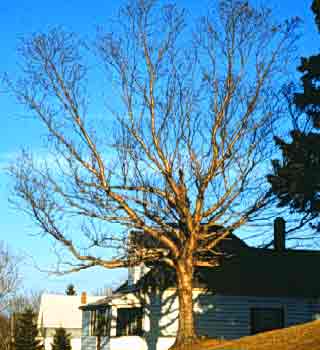 Sweet Birch - Betula lenta
Sweet Birch - Betula lenta
Birch Family (Betulaceae)
Introduction: The yellow fall foliage of sweet birch is considered the best fall color among cultivated birches in the Midwest. Sweet birch has attractive, dark shiny red, almost black bark that looks like that of the cherry tree and may be smooth or scaly plated. The tree is known for the strong wintergreen scent of its bark and leaves.
Culture: Sweet birch prefers deep, fertile, moist, well-drained soil that is slightly acidic. The tree is hardy to Zone 3 and will grow on rocky, dry sites in the wild, but hot, dry sites should be avoided if possible. It has been able to handle heavy soils in the Midwest. Sweet birch should not be pruned in spring because it "bleeds" excessively. This tree is resistant to bronze birch borer, and is more resistant to gypsy moth than other members of the genus. It can be susceptible to leaf spot, leaf rust, canker, dieback, wood decay, mildew, aphids, birch skeletonizer and seed mite gall.
- Native habitat: Southern Maine to Eastern Ohio, south to Kentucky, Alabama and Georgia. Sweet birch grows at elevations up to 4,000 feet in the Appalachians.
- Growth habit: Upright, pyramidal when young. Becomes rounded with an irregular crown as it matures.
- Tree size: 40 to 55 feet tall; 35 to 45 feet wide in landscape settings. In the wild it may grow to heights of 80 feet.
- Flower and fruit: Sweet birch is monoecious. Pendulous male catkins are 3 to 4 inches long when they mature in spring and have red-brown scales with sharp tips. Female catkins are only 3/4 of an inch long, upright, with light green scales, round tips and pink styles. Flowers appear before leaves in April. Fruit is a winged nutlet in a 3/4- to 1 1/3-inch-long, 3/5-inch-wide strobile.
 Leaf: Simple, alternate, 2 1/2 to 6 inches long and 1 1/2 to 3 1/2 inches wide. Glossy green leaves turn yellow in fall.
Leaf: Simple, alternate, 2 1/2 to 6 inches long and 1 1/2 to 3 1/2 inches wide. Glossy green leaves turn yellow in fall.- Hardiness: Winter hardy to USDA Zone 3.
Additional information:
The wood of sweet birch is medium heavy, medium hard and dark brown with a little red. Sapwood is light brown or yellow. The wood, which tends to warp, slowly gets darker after it is exposed to air. Over time, furniture made from sweet birch looks like mahogany, and its wood is stronger than mahogany and black cherry. It takes about 150 years for sweet birch to reach a size that appeals to loggers.
The wood of sweet birch is medium heavy, medium hard and dark brown with a little red. Sapwood is light brown or yellow. The wood, which tends to warp, slowly gets darker after it is exposed to air. Over time, furniture made from sweet birch looks like mahogany, and its wood is stronger than mahogany and black cherry. It takes about 150 years for sweet birch to reach a size that appeals to loggers.
The inner bark of sweet birch has a strong wintergreen scent, which led to its use in the production of oil of wintergreen. The wintergreen produced from sweet birch is identical to that produced by the wintergreen plant. In the past, people who lived in the Appalachians cut down large numbers of sweet birches to produce oil of wintergreen. Around 100 saplings and young trees were needed to produce a quart of the product, which was sold to druggists to flavor candy and medicines. Oil of wintergreen is now produced synthetically.
Sweet birch was introduced into the landscape in 1759. It has had another interesting use. Its sap can be combined with corn and fermented to make beer.




